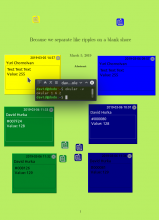The user can choose the blue or some dark color for annotation background and the black text is hardly visible on such backgrounds.
Example:
This patch tries to use the luminance of background to determine what color (white or black) should be used for the text.
I know that it's a silly thing to use the dark background for the black text but it seems that someone's gotta do it. ;)
Currently, you should type something in the pop-up note to make the text visible. I could not find the right place for the color change yet. The help in determining the entry point to change the color from the beginning will be much appreciated.
BUG: 405105



